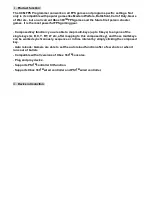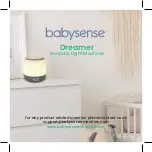
FRX100 III Housing Instruction Manual 20141005
20
6.
Note that once the camera built-in flash has been popped up, it can be disabled again using the
Flash / Right
control
(page 10, no. 15) and selecting “flash disabled” on the flash mode menu.
Turning the Flash Pop-Up control clockwise will not have any effect on the built-in flash.
When shooting in M (Manual), A (Aperture priority) or S (Shutter Speed priority) shooting modes,
please take into consideration that once the flash has been popped up – it cannot be disabled.
Therefore, in such cases, it's recommended to switch to Auto shooting mode to eliminate the flash
after it has been popped up.
OPTIONAL ACCESSORIES
For the full selection of Fantasea accessories compatible with
the FRX100 III Housing
, please
refer to the Fantasea website
–
WWW.FANTASEA.COM
EXTERNAL FLASHES
Underwater flashes and strobes were designed to improve the color, lighting and quality of your
underwater images. Since light and color are absorbed by water, using an external flash is recommended in
all depths, during daylight and night dives. In addition to retrieving the color and light absorbed by water,
underwater flashes also allow for creative lighting, assist in reducing the amount of backscatter and prevent
the shadowing effect caused by the housing lens port when using the built-in camera flash, especially when
accessory lenses are mounted on the housing.
The
FRX100 III Housing
can be used with underwater slave flashes. These external flashes feature a slave
sensor which triggers the external flash to fire in sync with the internal camera flash.
Most underwater slave strobes are capable of synchronizing with the internal camera flash without any
cables under certain diving conditions. They feature a slave sensor that triggers the strobe to fire in sync
with the camera built-in flash as long as the strobe and the camera are positioned on the same axis and as
long as there is not much ambient light available. However, if the strobe slave sensor isn’t pointed directly
at the internal camera flash, or when photographing during daylight, in clear water and bright conditions,
the slave sensor might fail recognizing the output of the internal camera flash. Connecting a fiber optic
cable between the internal camera flash and the slave strobe ensures full synchronization in all angles and
diving conditions.
Attaching Fiber Optic Cables to the Housing
1.
When installed on the housing, the fiber optic cable plate and the two adaptors inserted inside it
allow for an easy attachment of up to 2 fiber optic cables to the housing.












































